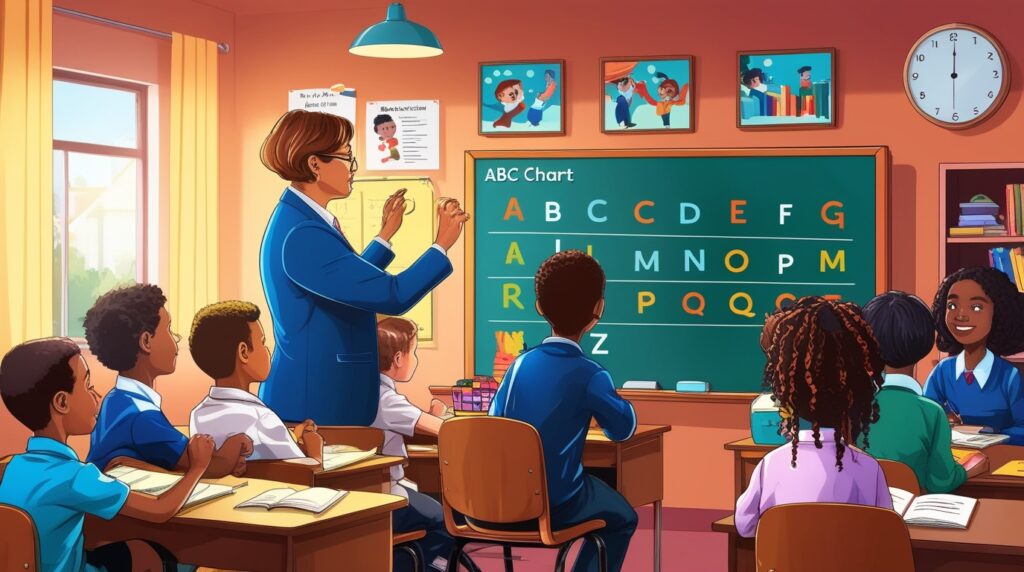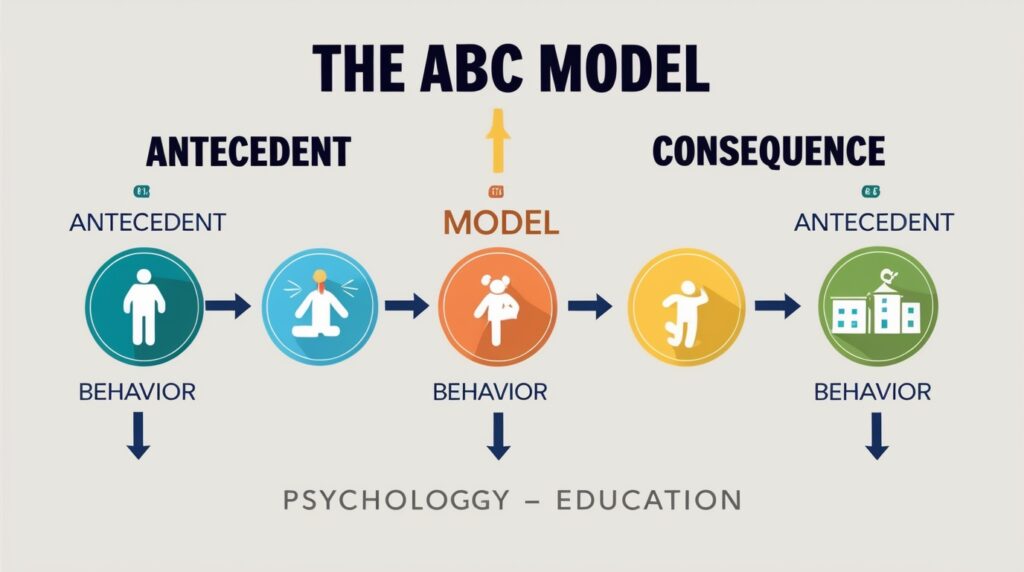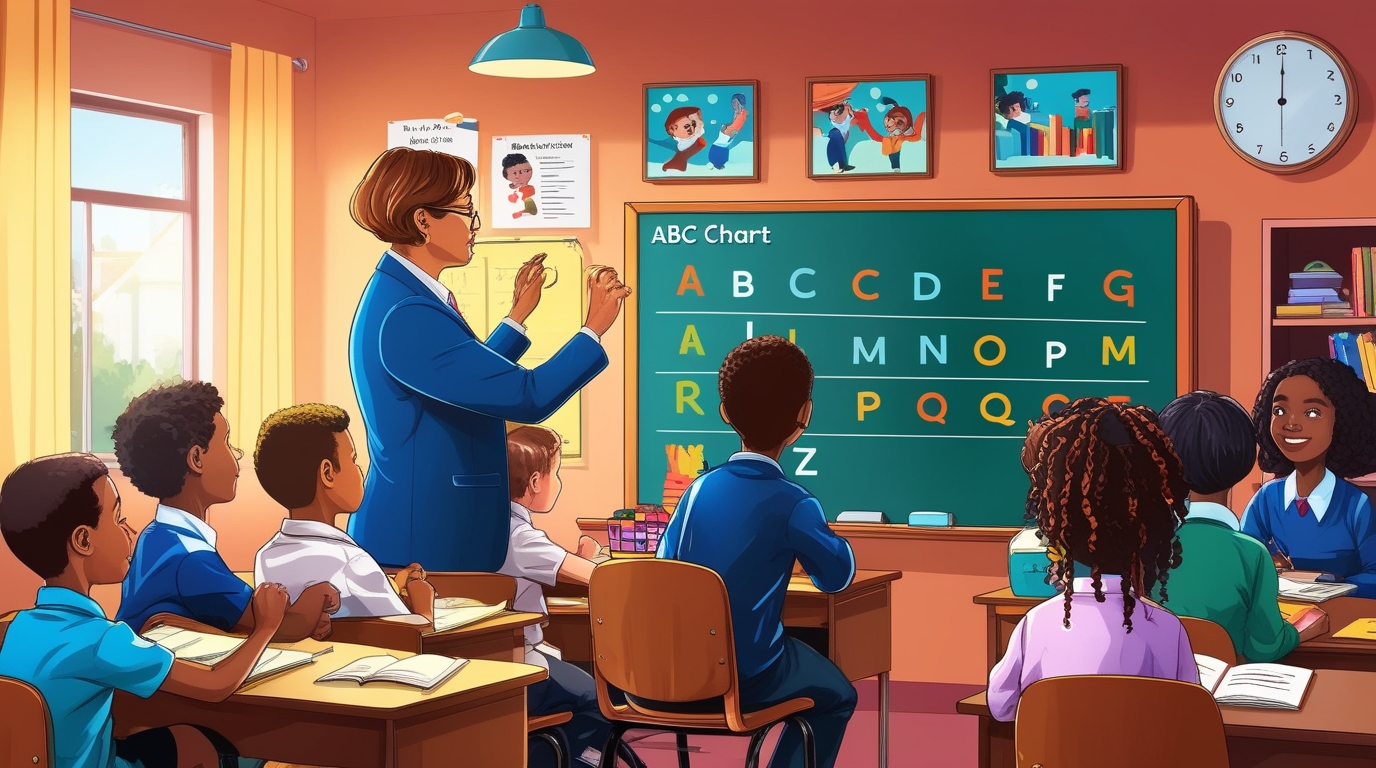ABC Chart: A Complete Guide to Behavior Analysis and Classroom Management
Introduction to the ABC Chart
What Is an ABC Chart?
An ABC Chart is a structured tool used to record and analyze behaviors to understand why they occur and how to manage them effectively. “ABC” stands for Antecedent, Behavior, and Consequence — the three critical components that help in identifying behavior patterns. The chart captures what happens before the behavior (Antecedent), the behavior itself, and what happens after it (Consequence).
In simpler terms, think of the ABC chart as a detective’s notebook for human actions. It helps teachers, parents, and therapists uncover what triggers certain behaviors and how those behaviors are maintained. This understanding becomes the foundation for creating behavior intervention plans (BIPs) and improving classroom management strategies.
The ABC chart is commonly used in Applied Behavior Analysis (ABA), special education, and psychology. It offers a data-driven approach, focusing on observation rather than assumption. For example, if a student throws a tantrum during reading time, the chart helps reveal whether the cause is frustration, attention-seeking, or avoidance.
Over time, the ABC method promotes better decision-making and supports personalized interventions. It transforms chaotic, unexplained behavior into structured information that can guide teachers, caregivers, and therapists toward consistent improvement.
Importance of the ABC Chart in Behavior Analysis

The ABC chart is a cornerstone of behavior analysis because it bridges the gap between observation and understanding. Instead of labeling a student as “disruptive,” the chart helps identify the reason behind their behavior. Is the behavior triggered by environmental stress? Peer pressure? Lack of engagement? Once these triggers are identified, interventions can be more targeted and effective.
In behavioral therapy, the ABC chart functions as a diagnostic and intervention tool. Therapists use it to pinpoint what motivates a person’s behavior — whether positive reinforcement (like praise) or negative reinforcement (like escaping a task). This knowledge helps in designing functional behavior assessments (FBA) and individualized behavior plans.
For educators, the chart provides valuable insights into classroom dynamics. It promotes positive behavioral support (PBS) and helps reduce punitive measures. When teachers know the “why” behind behaviors, they can shift from punishment to proactive strategies — encouraging better emotional regulation and student engagement.
Furthermore, the ABC chart strengthens communication among parents, teachers, and therapists. Everyone gets a clear, consistent record of behavior trends. The result? More informed decisions and more compassionate responses.
Brief History and Development of the ABC Model
The ABC model originates from the field of behaviorism, a psychological approach founded by B.F. Skinner in the mid-20th century. Skinner emphasized that behavior is not random but influenced by environmental factors and consequences. This gave rise to the operant conditioning theory — the idea that behaviors are shaped and maintained by what happens afterward.
Over time, this theory evolved into a practical framework for analyzing and modifying human behavior. The ABC chart became a visual representation of Skinner’s principles, allowing practitioners to observe behavior objectively and systematically.
By the 1970s, with the emergence of Applied Behavior Analysis (ABA), the ABC method became a standard tool in educational psychology, special education, and therapy for children with developmental disorders like autism. It allowed professionals to move away from subjective judgments and rely on evidence-based interventions.
Today, the ABC model is widely used across disciplines — from classrooms and clinical settings to workplace training programs. Its adaptability and simplicity make it an essential part of any behavior management toolkit.
Understanding the ABC Framework
Breaking Down the ABC — Antecedent, Behavior, Consequence
To use the ABC chart effectively, one must understand its three main elements. Each plays a crucial role in uncovering the root causes of behavior and designing meaningful interventions.
Antecedent – The Trigger
The antecedent refers to what happens right before the behavior occurs. It includes environmental factors, instructions, interactions, or even emotional states that may influence the behavior. For instance, a child might act out when asked to complete a difficult math problem, or a student may become disengaged after being corrected publicly.
By observing antecedents, we can pinpoint triggers — the situations, people, or events that precede certain actions. Understanding these helps modify the environment to prevent undesired behaviors before they even occur. For example, changing how instructions are given or offering breaks can reduce stress-related outbursts.
Recording antecedents accurately requires careful observation. Practitioners should note details like time, location, context, and tone of voice. Over time, patterns emerge, revealing how environmental cues influence behavior.
Behavior – The Observable Action
The behavior section documents the specific, observable action the individual exhibits. This step must be descriptive, not interpretive. Instead of writing “student was rude,” a proper entry might say, “student shouted at the teacher and left the desk.”
The key is objectivity. Avoid assumptions about intent or emotion; focus on what can be seen or heard. This ensures consistency across observations and makes it easier to compare data over time.
The behavior component helps identify frequency, duration, and intensity. Does the behavior happen once a day or multiple times an hour? How long does it last? Is it mild, moderate, or severe? Quantifying these factors helps measure progress and evaluate intervention success.
Consequence – The Result or Response
The consequence represents what happens immediately after the behavior. It could be an external response (like a teacher giving attention) or a natural outcome (like escaping a task). The consequence determines whether the behavior is reinforced or discouraged in the future.
For example, if a child throws a tantrum to avoid a math assignment and is excused, that behavior has been reinforced through negative reinforcement. Conversely, if the child is calmly redirected and then praised for completing the task, positive reinforcement occurs — encouraging better behavior next time.
By analyzing consequences, we can reshape responses to promote desired behaviors. It’s not about punishment but about teaching replacement behaviors that serve the same function in a healthier way.
How the ABC Model Works in Practice
In practice, the ABC model functions like a feedback loop. Observers collect data using the chart, analyze patterns, and implement strategies to change the environment or response system. Over time, this helps reduce negative behaviors and reinforce positive ones.
For instance, in a classroom, a teacher might notice that a student talks out of turn whenever group activities begin. By using an ABC chart, the teacher identifies that the antecedent is the start of group work, the behavior is talking loudly, and the consequence is attention from peers. The solution might involve preparing structured roles or offering positive reinforcement when the student waits their turn.
The power of the ABC model lies in its evidence-based simplicity. It transforms behavioral observations into actionable insights, allowing educators and therapists to replace reactive management with proactive support.
Key Principles Behind Behavior Tracking
Effective behavior tracking using ABC charts relies on several key principles:
- Consistency – Regular observation ensures accuracy and reliability.
- Objectivity – Focus on facts, not assumptions.
- Pattern Recognition – Look for repeated triggers or consequences.
- Collaboration – Share data among teachers, parents, and therapists.
- Continuous Improvement – Adjust interventions based on outcomes.
When applied consistently, the ABC model becomes more than a chart — it becomes a behavioral roadmap, guiding sustainable improvements in learning and communication.
How to Create an ABC Chart

Essential Components of an ABC Chart
Creating an effective ABC Chart starts with understanding its essential components. The goal is to ensure that the chart captures clear, measurable, and actionable data. Whether used in classrooms, therapy sessions, or workplaces, a well-structured chart should include specific sections that make behavior analysis simple and consistent.
Here are the core components every ABC chart should have:
- Date and Time – Document when the behavior occurred. This helps identify patterns over time, such as whether a behavior happens more frequently during a particular class or time of day.
- Location/Setting – Where did the behavior occur? The environment often influences behavior.
- Antecedent (What Happened Before) – Describe the event, instruction, or situation that occurred right before the behavior.
- Behavior (What Was Observed) – Record the exact behavior, not assumptions. For example, “student shouted and left seat” instead of “student was angry.”
- Consequence (What Happened After) – Note the immediate response to the behavior. Did the teacher intervene? Did peers react? Did the student receive attention or avoid a task?
- Possible Function of Behavior – Identify why the behavior might have occurred — to gain attention, escape a task, seek sensory stimulation, etc.
- Observer Notes – Space for additional observations, context, or insights that may help explain patterns.
A simple table format is usually the most efficient layout for ABC charts. Here’s an example:
| Date/Time | Setting | Antecedent | Behavior | Consequence | Function | Notes |
|---|---|---|---|---|---|---|
| 10/18/25, 10 AM | Math class | Teacher asked to read aloud | Student yelled “No!” and threw book | Sent to hallway | Escape task | Happens during reading activities |
This format encourages consistency and makes it easier to analyze patterns later. A detailed chart helps teams work together, ensuring every observation is factual and useful for intervention planning.
Step-by-Step Process to Build an Effective ABC Chart
Creating an ABC chart isn’t just about filling boxes; it’s about systematic observation. Here’s a step-by-step guide:
- Define the Target Behavior
Be clear about the behavior you want to track. Avoid vague terms. Instead of writing “disruptive,” describe the behavior like “throws pencils” or “talks over others.” This makes tracking measurable and precise. - Choose a Recording Method
Decide whether observations will be written manually or recorded digitally. Many professionals use spreadsheet templates or apps to store and share data easily. - Observe and Record Consistently
Observe the behavior as it happens. Record the antecedent, behavior, and consequence in real-time if possible. Avoid guessing or filling in details later — accuracy matters. - Collect Enough Data
One or two instances won’t show reliable trends. Track multiple occurrences across days or weeks to see clear behavioral patterns. - Analyze the Patterns
Once enough data is collected, identify what triggers the behavior and how the environment or responses may be maintaining it. For example, if a child misbehaves to avoid math, the function might be escape. - Develop Interventions
Based on your analysis, modify antecedents (prevent triggers) or consequences (change outcomes). Reinforce desired behaviors and reduce reinforcement for undesired ones. - Review and Adjust Regularly
Behavior tracking is an ongoing process. Reassess weekly or monthly to determine if the interventions are working or need refinement.
By following this process, the ABC chart transforms from a simple log into a powerful behavior management tool. Over time, consistent documentation reveals deep insights that can reshape learning environments and improve emotional regulation.
Example Templates and Practical Layouts
Here are three practical ABC chart templates commonly used in classrooms and therapy settings:
Basic ABC Template (Ideal for Teachers
Date/Time: _____________
Student: _______________
Antecedent: ____________
Behavior: ______________
Consequence: ___________
Function: ______________
Notes: _________________Detailed Behavioral Observation Chart (Therapist Version)
Date: _______ | Time: _______ | Setting: _______
Target Behavior: _____________________________
Antecedent: _________________________________
Behavior Description: ________________________
Consequence Observed: ________________________
Possible Function: ___________________________
Frequency: ____ | Duration: ____
Intervention Used: ___________________________
Follow-Up Notes: _____________________________
Digital Spreadsheet Format
Professionals who prefer data analytics can use Excel or Google Sheets to automate charting. Columns can be color-coded by frequency or type of behavior, making visual patterns easier to identify.
By using structured formats, teams can ensure uniform data collection and streamline collaboration between teachers, therapists, and parents. Templates also reduce bias by forcing observers to focus on facts, not assumptions.
Using the ABC Chart in Education
Role of Teachers and Educators
Teachers play a critical role in using ABC charts effectively. In classrooms, behavioral issues can disrupt not only learning for one student but for the entire group. The ABC chart empowers teachers to address root causes instead of reacting impulsively to symptoms.
Educators use ABC charts to:
- Track recurring behaviors over time.
- Identify environmental triggers, such as certain subjects, peers, or transitions.
- Implement behavior intervention plans (BIPs) tailored to each student.
- Collaborate with school psychologists or counselors for comprehensive support.
For instance, if a teacher notices that a student frequently leaves their seat during math lessons, the ABC chart might reveal that the behavior occurs after the teacher gives multi-step instructions — a sign that the child may struggle with processing complex information. Instead of punishing the student, the teacher can simplify instructions, provide visual aids, or offer movement breaks.
Teachers also use the data from ABC charts to communicate with parents more effectively. Instead of vague reports like “your child is acting out,” educators can show clear patterns backed by data. This transparency strengthens parent-teacher relationships and ensures consistent strategies at home and school.
In special education, the ABC chart is indispensable. It aligns with Individualized Education Programs (IEPs) and helps monitor progress toward behavioral goals. It’s not just a documentation tool — it’s a roadmap for improving student engagement, motivation, and social skills.
Identifying Behavioral Patterns in Students
One of the most valuable outcomes of using an ABC chart in education is the ability to identify behavioral patterns that might otherwise go unnoticed. Repeated observations often reveal that certain triggers — like loud noises, transitions, or specific tasks — consistently lead to undesired behaviors.
For example:
- A child who disrupts lessons after recess might be overstimulated.
- A student who refuses to participate in group work might be anxious about social interaction.
- A learner who constantly jokes during lessons may be seeking attention.
Once these patterns are recognized, teachers can proactively modify classroom routines or introduce support mechanisms. This could include visual schedules, positive reinforcement systems, or quiet zones for self-regulation.
Pattern recognition also helps teachers distinguish between skill deficits and performance issues. Some students misbehave because they can’t do the task (skill deficit), while others do so because they won’t (performance issue). The ABC chart helps clarify which is which, ensuring interventions target the right root cause.
Ultimately, identifying patterns allows educators to build inclusive, supportive classrooms that cater to diverse learning needs — promoting empathy, patience, and positive relationships.
Real-Life Case Studies from Classrooms
To better understand how the ABC chart works in real life, let’s explore two brief classroom examples:
Case Study 1: The Disruptive Reader
A third-grade teacher noticed that one student, Jake, frequently shouted “I hate reading!” during language arts. Using an ABC chart, the teacher tracked the behavior for two weeks and found the pattern:
- Antecedent – Being asked to read aloud.
- Behavior – Refusing, shouting, and leaving the seat.
- Consequence – Being allowed to skip reading.
After analyzing the chart, the teacher realized Jake’s behavior was reinforced by avoiding reading. The solution? The teacher introduced paired reading with a peer, offered positive reinforcement after short reading segments, and gradually increased reading time. Within three weeks, Jake’s outbursts decreased dramatically.
Case Study 2: The Class Clown
In another classroom, Maya constantly interrupted lessons with jokes. The teacher charted her behavior and discovered that she often acted out during boring segments and after peers laughed. The pattern showed that Maya’s behavior was attention-seeking. Instead of punishing her, the teacher gave her a leadership role in class discussions, channeling her energy into productive participation. The result was improved focus and classroom harmony.
These examples highlight how data-driven observation, not guesswork, leads to meaningful behavioral change.
Implementing ABC Charts in Behavior Therapy

Application in Applied Behavior Analysis (ABA)
The ABC Chart plays a central role in Applied Behavior Analysis (ABA), a therapy method grounded in behavioral psychology. ABA focuses on understanding how behaviors work, what influences them, and how learning occurs. By using the ABC framework, therapists can pinpoint why a behavior happens and how to modify environmental conditions to encourage positive alternatives.
In ABA, therapists rely on the ABC model to conduct Functional Behavior Assessments (FBA). During this process, they collect data over several sessions to identify consistent patterns — for example, whether a child’s tantrums occur after a specific request or environment. This data helps determine the function of behavior, which typically falls into one of four categories:
- Attention-seeking – The individual behaves in a way to gain attention from others.
- Escape or avoidance – The behavior helps the person avoid something unpleasant (like a task or situation).
- Access to tangibles – The behavior is performed to get an item or activity (like toys or snacks).
- Sensory stimulation – The behavior provides internal pleasure or sensory input (common in autism).
Once the function is identified, the therapist develops a Behavior Intervention Plan (BIP) tailored to the individual’s needs. This plan outlines strategies to reduce problematic behaviors and reinforce desired ones. For example, if a child screams to get attention, the therapist may teach them to raise their hand instead — and reward them when they do.
The ABC chart allows therapists to measure progress over time. By tracking antecedents and consequences, they can adjust strategies to ensure lasting change. It also provides objective evidence for parents, educators, and support teams, ensuring that everyone works together consistently.
Ultimately, the ABC model in ABA therapy fosters behavioral awareness and accountability. It empowers individuals to learn appropriate behaviors while helping caregivers respond with empathy and structure.
Benefits for Children with Autism or ADHD
Children with Autism Spectrum Disorder (ASD) or Attention-Deficit/Hyperactivity Disorder (ADHD) often experience behavioral challenges due to differences in communication, sensory processing, and emotional regulation. The ABC Chart offers a structured, nonjudgmental way to observe these behaviors and uncover the “why” behind them.
For children with autism, behaviors like hand-flapping, running away, or meltdowns can seem random, but through the ABC chart, patterns become clear. For example:
- Antecedent: The child is overwhelmed by loud noise in the cafeteria.
- Behavior: The child covers ears and screams.
- Consequence: The teacher removes them from the room.
The chart reveals that the consequence (leaving the cafeteria) reinforces the behavior, as it helps the child escape sensory overload. The solution? Introduce noise-canceling headphones or a quiet corner, so the child learns to cope without acting out.
For children with ADHD, behaviors often stem from impulsivity, boredom, or difficulty maintaining attention. By using the ABC method, teachers and parents can identify triggering environments (like lengthy tasks or minimal movement) and adjust the setting to improve focus. For instance, allowing movement breaks or hands-on learning may significantly reduce restlessness.
The key benefits of using an ABC chart with children who have ASD or ADHD include:
- Personalized understanding of behavioral triggers.
- Improved communication between children and caregivers.
- Data-driven interventions rather than guesswork.
- Reduction in negative behaviors and increase in positive coping mechanisms.
- Enhanced consistency across home, school, and therapy environments.
When used regularly, the ABC chart becomes a transformative support tool — helping children develop emotional control and giving adults the roadmap to guide them with compassion and structure.
Therapist-Parent Collaboration Strategies
The success of any behavior intervention plan depends on collaboration between therapists, parents, and teachers. The ABC chart acts as a shared language that unites all parties under a common goal: understanding and improving behavior patterns.
Here are some effective strategies to enhance therapist-parent collaboration using ABC charts:
- Shared Documentation
Therapists can provide digital or printed copies of the ABC chart for parents to fill out at home. This ensures continuity of data across different environments — home, school, and therapy sessions. - Regular Progress Meetings
Holding weekly or biweekly meetings to discuss patterns helps refine interventions. Parents can share updates, and therapists can adjust the strategies accordingly. - Parent Training and Education
Therapists should train parents on how to identify antecedents and consequences accurately. This knowledge empowers parents to manage behaviors independently while maintaining consistency. - Reinforcement Consistency
Parents and therapists should agree on consistent reinforcement systems. For example, if a therapist uses token rewards for good behavior, parents should continue the same at home to strengthen learning. - Empathy and Communication
Behavioral change takes time. Open communication and empathy between caregivers and therapists prevent frustration and promote long-term success.
Collaboration through ABC tracking ensures that all adults in a child’s life are on the same page — using evidence-based insights to create a nurturing, structured environment.
Advantages and Limitations of Using ABC Charts
Advantages of the ABC Chart
The ABC Chart is celebrated for its simplicity and effectiveness in understanding complex behaviors. Below are the key advantages:
- Clarity and Structure – It simplifies behavior analysis into clear steps, making it accessible to teachers, parents, and professionals.
- Data-Driven Decisions – Instead of relying on assumptions, decisions are backed by observable patterns and facts.
- Prevention-Focused – Helps identify triggers and modify environments before problems occur.
- Promotes Positive Reinforcement – Encourages replacing negative behaviors with positive alternatives.
- Supports Communication – Offers a shared language for educators, parents, and therapists to collaborate effectively.
- Adaptable Tool – Useful across multiple settings, including schools, clinics, and workplaces.
For example, a teacher dealing with a disruptive classroom can use ABC tracking to adjust seating arrangements, alter task structures, or introduce incentives based on what the chart reveals. Similarly, a therapist working with a child can use it to monitor progress and fine-tune behavioral plans over time.
Limitations and Common Challenges
While the ABC chart is a powerful tool, it does have certain limitations. Understanding these ensures realistic expectations and effective application:
- Time-Consuming – Continuous observation and data recording require patience and consistency.
- Observer Bias – Inaccurate or subjective entries can distort results. Proper training reduces this risk.
- Complex Behaviors – Not all behaviors have clear antecedents or consequences, making analysis challenging.
- Environmental Variability – Behavior triggers can change based on location, time, or people present, requiring frequent updates.
- Overemphasis on Behavior – Focusing solely on observable behavior may overlook underlying emotional or psychological causes.
To minimize these challenges, it’s crucial to combine ABC charting with qualitative insights and professional interpretation. Data collection is just the first step — understanding and empathy must follow to ensure meaningful change.
Integrating ABC Charts with Modern Technology
Digital Behavior Tracking Tools
In today’s digital age, technology has transformed how ABC charts are used. Many educators and therapists now rely on digital behavior tracking apps and online platforms to streamline observation and analysis.
Digital ABC tools offer:
- Automated data entry with time stamps.
- Graphical analysis showing trends over weeks or months.
- Cloud-based collaboration for teams working remotely.
- Real-time alerts for high-frequency behaviors.
Popular tools like Behavior Tracker Pro, ABC Data Pro, and ClassDojo allow users to record antecedents, behaviors, and consequences on tablets or smartphones. These digital systems not only save time but also reduce human error, making the process more efficient and accurate.
Moreover, with AI-powered analytics, modern platforms can identify patterns automatically — predicting possible triggers and suggesting interventions based on past data. This integration of technology enhances the effectiveness of ABC charting and simplifies large-scale behavior management across classrooms or therapy centers.







